
HRSG polled 100+ HR professionals about job descriptions. Here are the surprising results

For such an important part of your HR processes, job descriptions are often overlooked as a talent management tool. Not only that, but the way that they’re put together has hardly evolved in the past generation of work. Even as HR teams increasingly use technology to work smarter and foster improved processes, most still stick to a tedious process for building and managing their job descriptions.
We wanted to get a better sense of how this looks in reality. How do HR professionals actually carry out their job description processes? Where is there room for improvement? How much time is being spent on these documents that, traditionally, aren’t often looked at or updated beyond the hiring process.
These are some of the key questions we sought out answers on from HRSG website visitors during the first quarter of 2019. If you’re a busy HR professional yourself, you’ll probably relate to some of the insights… but others may surprise you. Let’s get into the data.
Why do you write job descriptions (select all that apply)?
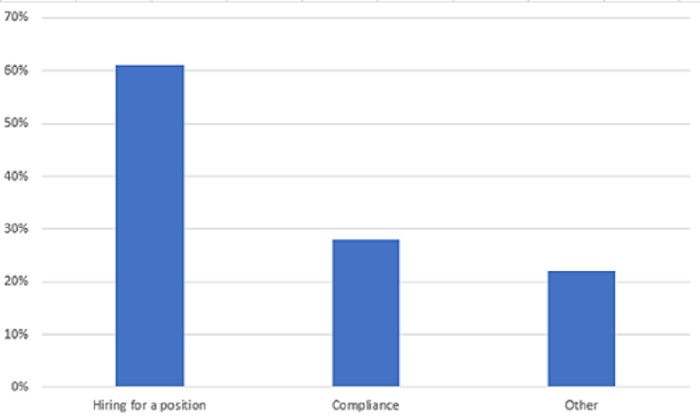
Let’s start with the basics: what's driving the creation of job descriptions? The need to hire someone is the dominant factor, but 28% of respondents also said that compliance issues played a role.
22% listed another reason as a factor. Write-in responses included:
KEY TAKEAWAY: Job descriptions are usually created when there's an immediate, pressing need to get someone on board. This puts a lot of pressure on the people responsible for putting them together and can be stressful when they don't have the right tools in place to create and manage descriptions quickly.
Do you have job descriptions for all positions in your organization?
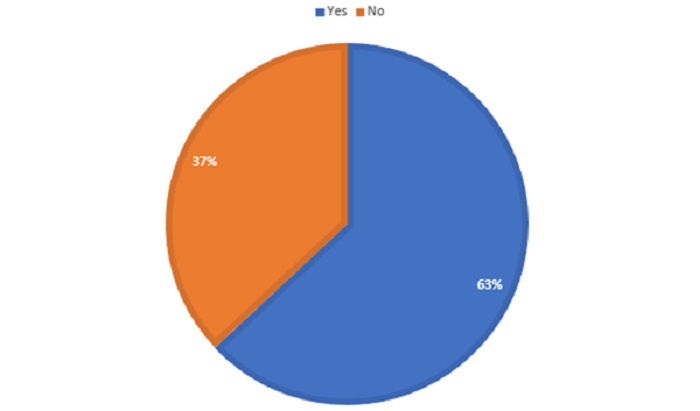
This question provided some slightly surprising results. Everybody’s got a job description, right? Well, apparently not. 37% of our respondents said that not every position in their organization has a job description.
KEY TAKEAWAY: There are a lot of employees out there with no official record of what their job entails. This is potentially somewhat troubling, in terms of performance management and compliance.
How often do you update your job descriptions?
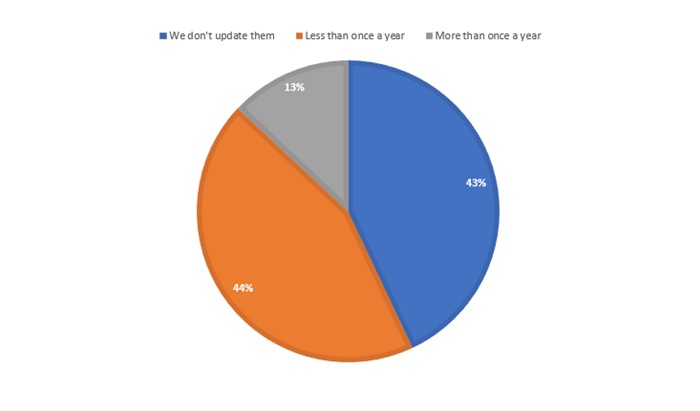
Let’s be honest, most roles change over time. But according to our research, this usually isn’t reflected in the job description. What’s the downside of keeping job descriptions the same? It has the potential to cause confusion and unhappiness when employees aren’t clear on their roles – or worse still, when they aren’t being assessed based on extra or changed responsibilities that they’ve taken on over time. 43% of our respondents said their company’s job descriptions aren’t updated regularly at all.
KEY TAKEAWAY: Even though almost everyone's role evolves over time, often that change isn't reflected in their job description.
How long does it typically take to write a job description?
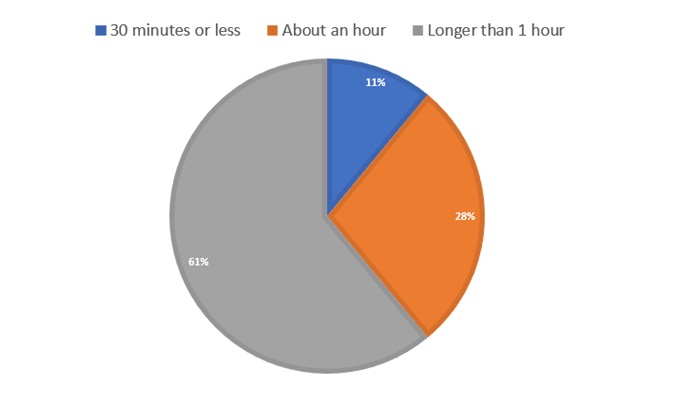
That last stat may shed some light on this one; perhaps one of the reasons that in many organizations, job descriptions aren’t regularly reviewed and updated is the time that it takes. 61% of our respondents said it takes them over 1 hour to write a job description. Kudos to the 11% of our respondents who don’t need any help and claim they can bang out a job description in 30 minutes or less. That’s speedy!
KEY TAKEAWAY: Almost 2/3rds of people spend an hour or more on every job description. Multiply that by dozens or hundreds of roles, and you can see the problem (our job description software significantly speeds up this process).
Where do you source information for job descriptions (select all that apply)?
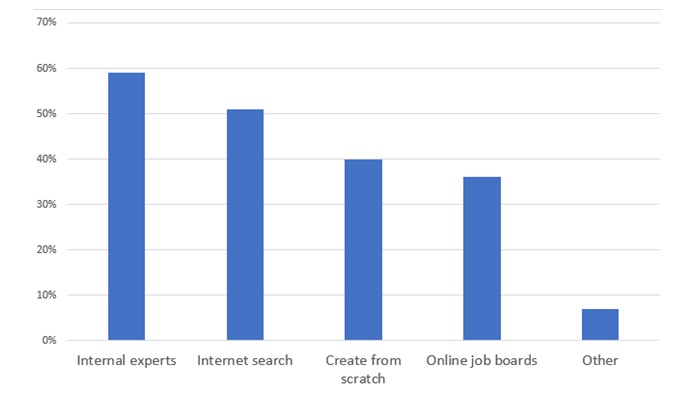
Our respondents indicated that they cobble together pieces of their job descriptions from a wide range of sources, including internal experts, searching around on the internet, and other places. 40% of respondents were brave souls who created all their job descriptions from scratch. Of note, some of the ‘other’ respondents said “all of the above.”
KEY TAKEAWAY: Most people pull the info for their job descriptions from a variety of places. This is definitely a contributing factor to why job descriptions take so long to write, for most professionals.
Do you merge job description information from multiple sources?
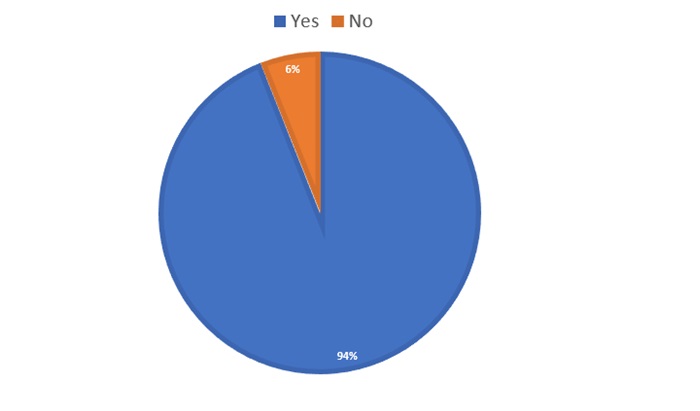
While we saw in the last question that people are using all sorts of different sources, one thing's clear: nearly everybody's doing it in one form or another.
KEY TAKEAWAY: Merging job description content from a variety of sources makes it very difficult to standardize them across the organization, and therefore difficult to use as dynamic talent records. It also raises the question of whether your job descriptions really reflect the voice of your organization?
Where do you keep your job descriptions (choose all that apply)?
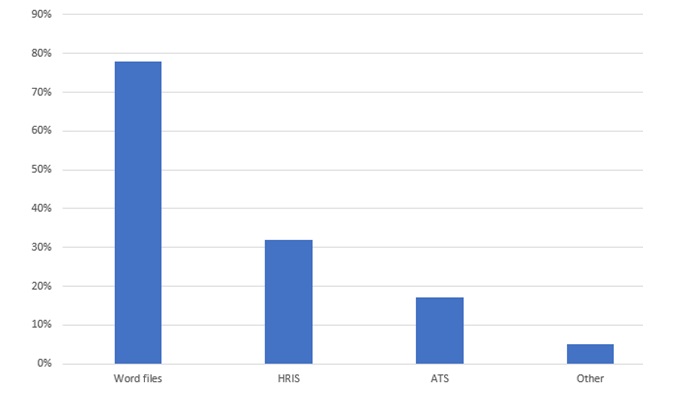
Here’s a final question that speaks to some of the other research data we uncovered. 73% are using Microsoft Word or a similar word processor to store their job descriptions. Another good portion of people have their job descriptions living in other HR systems, like HR Information Systems and Applicant Tracking Systems. Respondents who answered “Other” included:
KEY TAKEAWAYS: Word files are still the primary place that people keep their job descriptions. While it might work fine for small businesses, that can be a messy way to keep things organized for mid-sized and larger organizations.
So, let’s sum up. What does this data tell us?
A few themes emerged over the course of our research. Let's take a look at the top 3 insights that our respondents revealed.
1) Most organizations aren’t utilizing job descriptions to their full potential. We saw that in most companies, job descriptions are infrequently updated, if at all. And in a separate poll we ran, 62% of respondents said they only use job descriptions for hiring and recruiting. In actuality, the job description can serve as a dynamic talent management record – providing a solid foundation for not only recruitment, but the interview process (behavioral based interviews); assessment programs; development activities; and even career pathing programs.
2) There’s lots of room for process improvements. Most people are storing their job descriptions in word processors – the same as it’s been for, what, 25 or 30 years now? While technology has impacted every aspect of the modern HR professional’s existence (look no further than applicant tracking systems, learning management systems, or even the existence of online job boards), the key piece of collateral is still lingering in shared drives or on someone’s desktop. This can make it difficult to retrieve and update with any regularity. It also makes the revision process painful; who among us hasn’t gotten confused with multiple versions of documents floating around with multiple revisions from multiple stakeholders?
3) Frankenstein job descriptions rule the day. We’ve all done it: we need to get a job posting done and posted as quickly as possible, so we frantically Google, check with our bosses, pull from a bunch of different places until we’ve created a monster. But not only is this process time-consuming, it fosters inconsistent descriptions across your organization. How can you compare a junior and senior level of the same position if one description uses bullet points, while the other uses flowery, millennial-baiting paragraphs? And of course, if there are multiple people creating job descriptions, there's no way to give your company a consistent voice. Worst of all, job descriptions created like that are exceedingly difficult to use in any type of assessment, performance management or career pathing program.
Currently Facing these Challenges?
HRSG's SmartJD Technology — only available in CompetencyCore — gives you the tools to power your entire employee lifecycle through Smart Job Descriptions.
Use our exclusive AI to map skills and behaviors (competencies) to your jobs in a matter of minutes, and then build your programs around these dynamic talent management records. Build interview guides for hiring managers, run assessment programs, and provide employees with visual career pathing tools – all based on the embedded competencies on your standardized, organized job descriptions.
Book a demo today to start elevating your process and empowering your people, the smarter way.